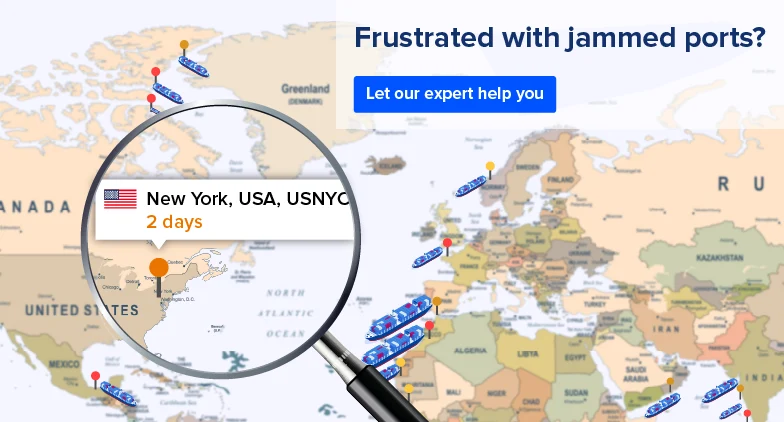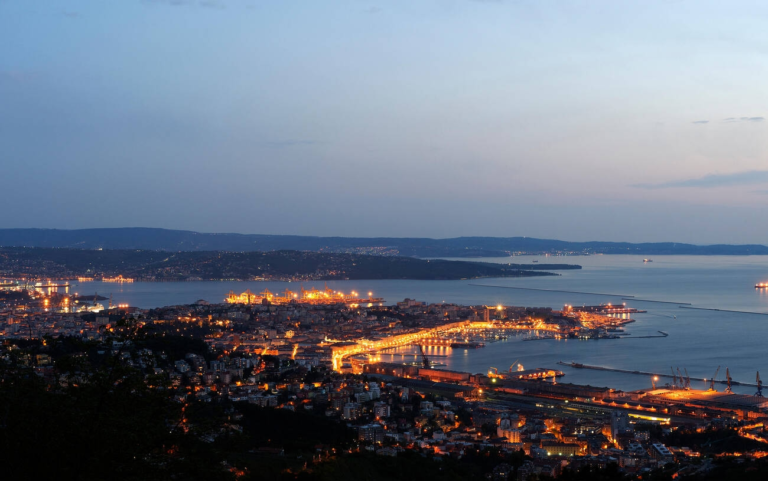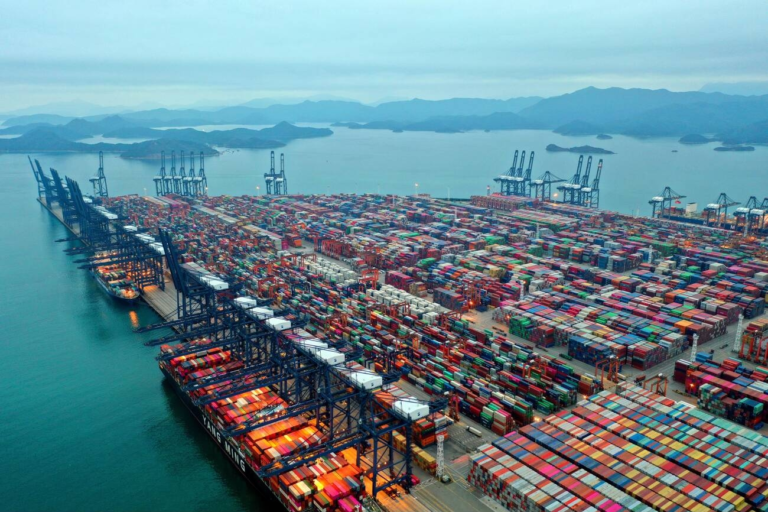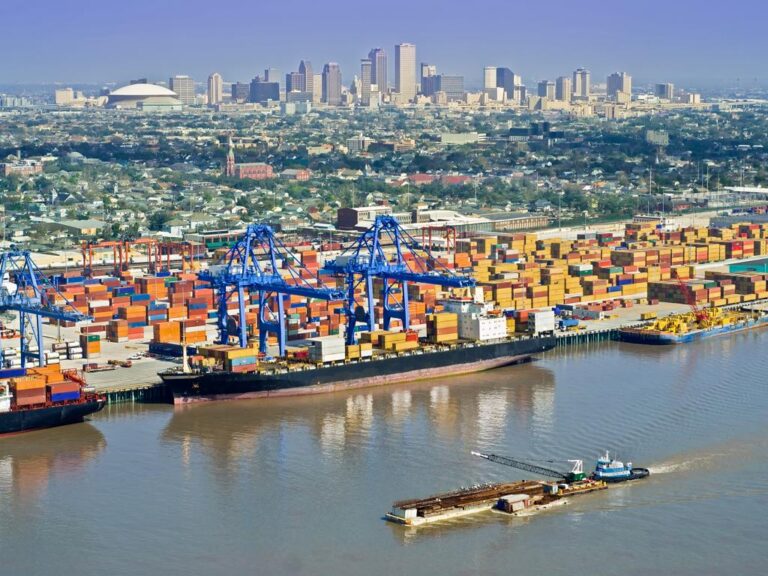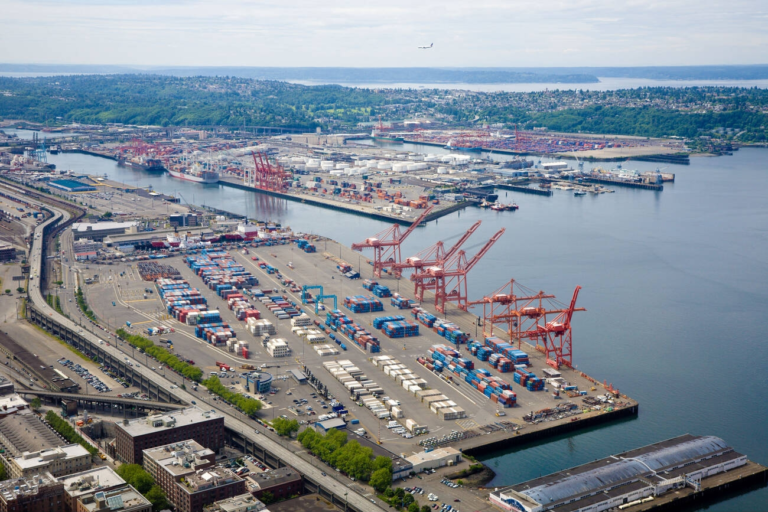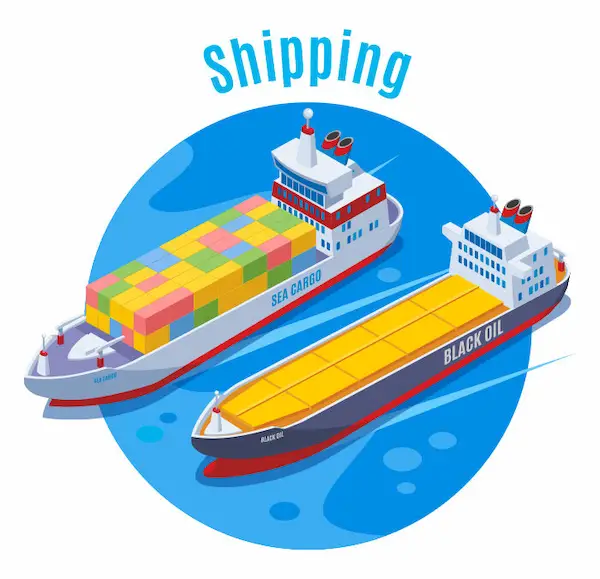Ports of Europe: Discover the Top 13 Largest and Busiest Hubs in 2025
From the bustling docks of Rotterdam to the sun-drenched shores of Barcelona, the ports of Europe are essential hubs of global trade and economic vitality. These impressive maritime giants are more than just towering structures; they are the lifelines of commerce, connecting continents and driving prosperity.
Why are Europe ports so crucial? The answer lies beyond their sheer size and constant activity. Each port is a powerhouse of innovation, efficiency, and economic impact. In this article, we explore the top 13 ports of Europe, uncovering their unique features, state-of-the-art technologies, and pivotal roles in international trade.
Stay informed and navigate your trade routes efficiently with comprehensive insights into the leading Europe ports. Discover how these ports are not only facilitating the flow of goods but also shaping the future of global trade and ensuring economic resilience.
The Importance of Ports in Europe
Europe’s trade arteries run not through bustling cities but through the unassuming giants on its coastline – its ports. These colossal structures stand as the silent engines of prosperity, pumping billions of euros worth of goods across continents and fueling the lifeblood of industries and nations.
Beyond their imposing figures of concrete and steel, these maritime gateways serve as pivotal arteries, pumping billions of euros worth of goods across continents. Their role is not merely passive; they act as catalysts, triggering a cascade of economic activity with each arriving container. From dockers unloading cargo to trucks transporting goods, factories whirring, and dealerships bustling with sales, these ports coordinate a complex process that keeps the continent’s economic engine purring.
But their impact extends beyond pure economics. Ports are also magnets for opportunity, attracting foreign investments and fostering thriving ecosystems of businesses. They act as ambassadors of cultural exchange, carrying stories, trends, and flavors from across the globe, enriching Europe’s tapestry with each vessel that arrives.
Criteria for Port Ranking
Cargo throughput: The sheer volume, measured in tonnes or TEUs (twenty-foot equivalent units), is the first major metric. Rotterdam, Antwerp, and Hamburg, Europe’s throughput titans, wear this crown with pride, their docks humming with the ceaseless dance of cargo movement.
Container capacity: But brute force needs finesse. A champion port must have the muscle to handle modern trade’s workhorses – container ships. The ability to efficiently process these giants, measured in container capacity, is another key crown jewel. Felixstowe and Valencia, masters of rapid container flow, stand tall among the elite in this category.
Technological infrastructure: The synergy of intellect complementing strength surpasses the effectiveness of either attribute in isolation. The level of automation, data-driven operations, and smart port initiatives employed for efficiency and transparency is another key criteria for port ranking.Rotterdam, with its automated terminals and predictive maintenance systems, shines as a leader in technological prowess.
Regional connectivity: A lone port, however mighty, cannot conquer the trade world alone. Seamless connectivity to Europe’s intricate network of inland waterways, roads, and railways is crucial. Ports of Europe like Hamburg, strategically positioned at the crossroads of major trade routes, wear this crown with distinction, their interconnectedness weaving them into the very fabric of European trade.
Detailed Analysis of the Busiest Ports of Europe for 2025
After understanding the quantitative benchmarks that define port excellence, we embark on a nuanced exploration of the top 13 ports of Europe for 2025. Beyond the numbers, we delve into the strategic intricacies that position these ports as vanguards in shaping the dynamic layers of European trade.
Rotterdam, Netherlands – Europe’s Busiest Port
Rotterdam hums with the constant drone of cranes and the salty symphony of the North Sea. This titan of throughput reigns supreme with a total of 14 million TEU’s and with a staggering 468 million tonnes of cargo in 2025. Its sprawling complex boasts 45 kilometers of quays, dwarfing most competitors. But Rotterdam isn’t just about brute force; it’s a champion of innovation. Its Maasvlakte 2 extension, built on reclaimed land, features automated container terminals and digital infrastructure that keeps the cargo flowing with clockwork precision.
Antwerp, Belgium – Key Trade Facilitator
Across the border, Antwerp stands as a testament to human ingenuity. Once a humble fishing village, it transformed itself into a logistical powerhouse through sheer grit and strategic alliances. Its recent merger with the port of Zeebrugge created a behemoth boasting a container capacity of 12 million TEUs and direct access to both the North Sea and inland waterways. Antwerp is a master of specialization, excelling in chemicals, diamonds, and perishables, making it a vital cog in Europe’s trade machinery.
Hamburg, Germany – Major Northern Gateway
Further north, Hamburg’s red-bricked warehouses whisper tales of centuries past. Yet, this historic port pulsates with modern efficiency with a container capacity of 8.3 million TEUs. Its strategic location on the Elbe River offers access to deep-sea vessels and connects seamlessly to inland waterways, making it a crucial trade corridor for Eastern Europe. Hamburg doesn’t shy away from innovation, deploying automated guided vehicles and digital freight platforms to further streamline its operations.
Bremerhaven, Germany – Critical Export/Import Hub
Bremerhaven is the quintessential underdog, defying its size to punch above its weight. This specialized port is Germany’s premier hub for car exports, boasting dedicated terminals for automotive giants like Mercedes-Benz and Volkswagen with a capacity of 4.8 million TEUs. Bremerhaven thrives on diversifying its offerings, handling everything from food and electronics to offshore wind turbine components. Its recent expansion projects solidify its position as a vital link in Europe’s import-export chain.
Valencia, Spain – Leading Mediterranean Port
Basking under the Spanish sun, Valencia is a Mediterranean marvel. Its vibrant container terminals handle over 5 million TEUs, making it a crucial gateway for Southern Europe. Valencia excels in diversifying its offerings, with dedicated terminals for refrigerated goods, automobiles, and even cruise ships. But its crown jewel is the Valenciaport Innovation Hub, a breeding ground for cutting-edge logistics solutions, cementing its status as a pioneer in sustainable and efficient port operations.
Algeciras, Spain – Vital Link between Europe and Africa
Nestled at the southern tip of Spain, Algeciras sits at the crossroads of continents. It’s the undisputed king of passenger traffic, with its ferries shuttling millions across the Strait of Gibraltar to Morocco. Its robust container terminal handles over 4.8 million TEUs, making it a key gateway for Europe-Africa trade. Algeciras is also a champion of sustainability, employing green technologies and renewable energy sources to minimize its environmental footprint.
Piraeus, Greece – Southeastern European Focal Point
Piraeus, the legendary Athenian port, has risen from ancient sands to become a modern trade juggernaut. Backed by Chinese investment, it has transformed into a bustling container hub, handling over 4.35 million TEUs in 2022. Its strategic location at the crossroads of East-West trade routes makes it a magnet for shipping lines and major logistics companies. Piraeus is also actively developing into a cruise port, promising to become a gateway for both cargo and tourist traffic.
Le Havre, France – France’s Largest Port
Le Havre, with its elegant Art Deco waterfront, is more than just a port; it’s a masterpiece of urban planning. This French powerhouse boasts a diverse cargo mix, ranging from containers and automobiles to coffee and bananas with a capacity of 3.1 million TEUs. Its state-of-the-art facilities, including automated container terminals and a sprawling logistics park, keep the goods flowing smoothly. Le Havre is also a pioneer in green initiatives, focusing on renewable energy and waste reduction, setting a sustainable example for its peers.
Felixstowe, United Kingdom – UK’s Principal Container Port
Across the English Channel, Felixstowe stands as the UK’s undisputed champion of container traffic. Handling over 3.85 million TEUs, it’s a hive of activity, humming with the constant movement of cranes and cargo. Felixstowe’s success lies in its focus on efficiency and automation. Its ultra-modern facilities and seamless integration with inland transport networks make it a logistical marvel. While navigating Brexit uncertainties, Felixstowe remains a vital link in the UK’s international trade tapestry.
Genoa, Italy – Italy’s Foremost Port
Genoa, a port with a history as rich as its pesto, has adapted to changing tides for centuries. This ancient harbor has reinvented itself into a modern container hub, handling over 2.8 million TEUs. Its location in the heart of the Mediterranean makes it a gateway for trade with Southern Europe and beyond. Genoa is also embracing innovation, with initiatives like its “Smart Port” program focusing on data-driven logistics and operational efficiency.
Barcelona, Spain – Major Hub for Spanish Maritime Trade
Barcelona, with its sun-kissed beaches and vibrant culture, is also a maritime force to be reckoned with. Its port hums with a diverse cargo mix, from containers and cruise ships to grains and chemicals with a capacity of 3.5 million TEUs. Barcelona’s strategic location on the Iberian Peninsula, coupled with its excellent rail and road connections, makes it a crucial distribution hub for Spain and beyond. The port is also actively investing in sustainability initiatives, aiming to become a leader in eco-friendly port operations.
Gdansk, Poland – Poland’s Primary Seaport
Gdansk, rising from the ashes of World War II, has become a symbol of Polish resilience and economic resurgence. This Baltic port serves as the country’s maritime gateway, handling over 22 million tonnes of cargo with a capacity of 3 million TEUs per year. Gdansk specializes in bulk goods like coal and oil, but it’s also diversifying into container traffic and offshore wind energy components. The port’s modern facilities and strategic location position it as a key player in the evolving Baltic trade landscape.
Marseille, France – Southern France’s Maritime Heart
Marseille, the vibrant Provençal port, embodies the spirit of the Mediterranean with a capacity of 1.5 million TEUs. Its bustling docks handle over 8 million tonnes of cargo, with a heavy focus on oil, chemicals, and food products. Marseille is also a major cruise ship destination, offering access to the alluring beauty of the French Riviera. The port is actively modernizing its infrastructure and investing in automation, aiming to maintain its position as a key economic engine for the region.
Technological Innovation in European Ports
These bustling docks of Europe aren’t just about brute force; they’re hotbeds of innovation & growth, embracing cutting-edge technologies to transform into “smart ports” of the future. Here’s a closer look at the exciting advancements driving efficiency, transparency, and sustainability:
Smart Port Initiatives
Forget monolithic giants of concrete and steel; these top ports of Europe are undergoing a metamorphosis. They’re no longer just arteries of trade, but intelligent hubs pulsing with the lifeblood of cutting-edge technology. This is the rise of the “smart port,” where robots dance with containers, data illuminates the supply chain, and algorithms weave a symphony of efficient movement.
Automated terminals are replacing manual labor, boosting efficiency and minimizing human error. Self-driving trucks navigate port grounds, optimizing routes and ensuring safety, while intelligent software platforms work the cranes, trucks, and cargo. Congestion? Not here. Advanced traffic management systems anticipate and eliminate bottlenecks, keeping the flow smooth and emissions low.
But the real secret lies beneath the surface. Real-time data, the all-seeing eye of the smart port, illuminates the journey of every container. Shippers, logistics providers, and port authorities alike can pinpoint location, condition, and ETA with astonishing precision. Predictive maintenance systems, powered by data analytics, whisper warnings before equipment falters, ensuring uninterrupted cargo flow and minimizing downtime.
These are just the opening chapters in the captivating story of smart port initiatives. By embracing technology, Europe’s maritime giants are not just revolutionizing efficiency; they’re building the future of global trade, brick by brick, sensor by sensor, algorithm by algorithm. So next time you savor a French pastry or marvel at a German-made car, remember the silent powerhouses on the coastline, where the future of trade is taking shape.
Green and Sustainable Practices
While towering cranes and bustling docks remain the face of the ports of Europe, behind the scenes, a crucial journey is underway – the quest for sustainability. These maritime giants, historically significant sources of pollution, are acknowledging their environmental impact and charting a course correction. While challenges remain, innovative initiatives are emerging, inching ports closer to a greener future.
Renewable energy, once a glimmer on the horizon, is gaining traction. Solar panels grace rooftops, harnessing the sun’s power to illuminate terminals. Wind turbines spin rhythmically, extracting clean energy from the harbor breeze. Even the ocean’s constant pulse is being harnessed through tidal power installations, offering a glimpse of what tomorrow’s ports could be.
But the quest for clean energy goes beyond rooftops. Electric vehicles are slowly replacing their diesel counterparts. Cranes lift containers with a quieter hum, while electric trucks navigate port grounds with minimal emissions. The once cacophony of diesel engines is giving way to a symphony of cleaner alternatives, in its early stages.
Green infrastructure, too, is receiving a makeover. Eco-friendly building materials are incorporated into new construction projects, and waste management initiatives emphasize responsible recycling and resource recovery. These ports of Europe are recognizing their role not just as trade gateways, but also as stewards of the environment, striving to minimize their footprint and set an example for other industries.
Certainly, the road to full sustainability is long and winding. Pollution remains a significant challenge, and the scale of port operations necessitates a gradual, systematic approach.
The Economic Impact of Major Ports of Europe
Navigating the path to sustainability is undeniably intricate, with pollution standing as a formidable challenge. In the realm of major ports of Europe, the sheer scale of operations demands a methodical, step-by-step strategy. Now, let’s delve into The Economic Impact of these pivotal ports, exploring the intersection of environmental resilience and economic prowess.
Contributions to Local and National Economies
The ports of Europe are more than hulking concrete giants dotting the coastline; they’re economic engines, pulsating with activity that fuels both local and national prosperity. Their impact is akin to a ripple effect, radiating outwards from busy docks to invigorate surrounding communities.
Direct job creation is palpable with towering cranes carrying containers, skilled workers orchestrate cargo movement, and trucks laden with goods weave through bustling streets. This generates livelihoods in stevedoring, shipping, terminal operations, and a multitude of associated industries. But the benefits extend far beyond the waterfront.
The port’s activity spawns a thriving ecosystem. Warehouses burgeon, logistics companies set up shop, and local businesses flourish on the increased trade. This indirect job creation strengthens neighborhoods, injects vibrancy into towns and cities, and bolsters regional GDPs through taxes, port fees, and the general economic bustle.
These maritime giants aren’t just local powerhouses; they’re bridges to the world. They connect local producers to the expansive canvas of global markets. Imagine a German engineering firm, utilizing the port’s logistics network, reaching new markets with their innovative products. This trade facilitation unlocks doors for local businesses, fueling their growth and expansion.
Ports as Trade and Logistics Centers
Beyond mere concrete giants, ports of Europe act as potent magnets for foreign investment, luring companies with their efficient trade corridors, skilled workforce, and robust infrastructure. Imagine the irresistible combination for international businesses: a streamlined gateway to global markets, coupled with readily available talent and resources. This influx of foreign capital creates new jobs, injects fresh ideas and technology, and propels both the port and surrounding region towards dynamic growth.
Furthermore, these bustling hubs act as catalysts for specialized service ecosystems. Logistics companies sprout like seeds, offering innovative solutions for streamlined cargo movement. Technology firms flourish, developing cutting-edge solutions to optimize port operations. Infrastructure projects connect ports to their hinterlands, further enhancing the flow of goods. This interconnected web of businesses amplifies the port’s economic impact, creating a synergistic ripple effect that benefits everyone.
Future Trends in Europe Ports Development
Moreover, these vibrant hubs serve as incubators for specialized service ecosystems. Logistics firms emerge, providing inventive solutions for efficient cargo flow. Concurrently, technology enterprises thrive, pioneering cutting-edge advancements to optimize port operations. As infrastructure projects extend connections between ports and hinterlands, the seamless flow of goods is further enhanced. This interwoven tapestry of businesses amplifies the economic impact of ports, setting the stage for an exploration of Future Trends in European Port Development.
Expansion Projects and Forecasts
The ports of Europe aren’t resting on their laurels. They’re constantly evolving, muscles rippling with ambitious expansion plans. Think of towering new terminals rising from the tide, dredging projects sculpting deeper channels, and infrastructure undergoing a complete overhaul. These aren’t just vanity projects; they’re strategic investments to handle ever-growing cargo volumes and stay ahead of the curve.
These ports are embracing intelligence to work smarter, not harder. Automation takes center stage, with robotic arms replacing manual labor and software optimizing every step of the journey. Imagine sleek drones buzzing overhead, scanning containers for security threats, while data-driven algorithms predict maintenance needs before breakdowns occur. This is the future of efficiency, the symphony of technology ensuring smooth cargo flow and maximum performance.
Adapting to Changing Trade Patterns
But the tide doesn’t always flow smoothly. Trade patterns ebb and shift, consumer demands evolve, and economic uncertainties lurk on the horizon. To navigate these choppy waters, ports of Europe are diversifying their skillsets. Think of niche markets carved out, catering to specialized cargos like pharmaceuticals or high-tech equipment. Picture warehouses transformed into value-added hubs, offering packaging, labeling, and assembly services beyond mere cargo handling. This agility is key to resilience, ensuring ports remain relevant and adaptable in the face of change.
Furthermore, they’re embracing the digital wave. Online marketplaces buzzing with container bookings, blockchain technology ensuring secure transactions, and e-commerce platforms streamlining the final leg of the journey to consumers’ doorsteps. This digital embrace isn’t just a fad; it’s a lifeline, ensuring ports cater to the ever-shifting demands of modern consumers and stay relevant in the face of changing buying habits.
And finally, they’re not building walls of concrete, but of resilience. With emergency protocols drilled and tested, robust supply chains diversifying sources of materials, and infrastructure designed to withstand potential disruptions. This proactive approach prepares ports for the unexpected, safeguarding their operations and ensuring they navigate turbulent economic waters with grace and stability.
These are just glimpses into the fascinating world of the ports of Europe’s expansion and adaptation. By embracing both muscle and intelligence, niche specialization and digital acumen, and resilience in the face of change, these maritime giants are not just weathering the storm of a changing world; they’re charting a course for a future where they remain essential arteries of global trade, throbbing with innovation and progress.
From the thundering cranes of Rotterdam to the sun-drenched docks of Barcelona, Europe’s ports hum with bustling docks and the salty symphony of the sea. These maritime giants are more than just concrete giants; they are the silent architects of prosperity, pulsating arteries of trade that connect continents and shape the economic landscape for generations to come.
But beyond the awe-inspiring scale and bustling activity lies a world of fascinating intricacies. We’ll be delving into the top 13 ports of Europe, their hidden workings, cutting-edge technologies, and profound economic impact. Additionally, we will be understanding how these marvels are not just shaping Europe’s trade landscape but are also paving the way for a sustainable future.
The Importance of Ports in Europe Trade
Europe’s trade arteries run not through bustling cities, but through the unassuming giants on its coastline – its ports. These colossal structures stand as the silent engines of prosperity, pumping billions of euros worth of goods across continents and fueling the lifeblood of industries and nations.
Beyond their imposing figures of concrete and steel, these maritime gateways serve as pivotal arteries, pumping billions of euros worth of goods across continents. Their role is not merely passive; they act as catalysts, triggering a cascade of economic activity with each arriving container. From dockers unloading cargo to trucks transporting goods, factories whirring, and dealerships bustling with sales, these ports coordinate a complex process that keeps the continent’s economic engine purring.
But their impact extends beyond pure economics. Ports are also magnets for opportunity, attracting foreign investments and fostering thriving ecosystems of businesses. They act as ambassadors of cultural exchange, carrying stories, trends, and flavors from across the globe, enriching Europe’s tapestry with each vessel that arrives.
As ports play a pivotal role in economic and cultural exchanges, it becomes essential to establish criteria for port ranking that go beyond economic indicators. Evaluating factors that will not only gauge economic prowess but also ensure that ports contribute holistically to global trade while fostering long-term growth and resilience is what we have taken into account.
Criteria for Port Ranking
Cargo throughput: The sheer volume, measured in tonnes or TEUs (twenty-foot equivalent units), is the first major metric. Rotterdam, Antwerp, and Hamburg, Europe’s throughput titans, wear this crown with pride, their docks humming with the ceaseless dance of cargo movement.
Container capacity: But brute force needs finesse. A champion port must have the muscle to handle modern trade’s workhorses – container ships. The ability to efficiently process these giants, measured in container capacity, is another key crown jewel. Felixstowe and Valencia, masters of rapid container flow, stand tall among the elite in this category.
Technological infrastructure: The synergy of intellect complementing strength surpasses the effectiveness of either attribute in isolation. The level of automation, data-driven operations, and smart port initiatives employed for efficiency and transparency is another key criteria for port ranking.Rotterdam, with its automated terminals and predictive maintenance systems, shines as a leader in technological prowess.
Regional connectivity: A lone port, however mighty, cannot conquer the trade world alone. Seamless connectivity to Europe’s intricate network of inland waterways, roads, and railways is crucial. Ports like Hamburg, strategically positioned at the crossroads of major trade routes, wear this crown with distinction, their interconnectedness weaving them into the very fabric of European trade.
Detailed Analysis of the Top 13 Ports in Europe for 2025
After understanding the quantitative benchmarks that define port excellence, we embark on a nuanced exploration of the top 13 European ports for 2025. Beyond the numbers, we delve into the strategic intricacies that position these ports as vanguards in shaping the dynamic layers of European trade.
Rotterdam, Netherlands – Europe’s Busiest Port
Rotterdam hums with the constant drone of cranes and the salty symphony of the North Sea. This titan of throughput reigns supreme with a total of 14 million TEU’s and with a staggering 468 million tonnes of cargo in 2025. Its sprawling complex boasts 45 kilometers of quays, dwarfing most competitors. But Rotterdam isn’t just about brute force; it’s a champion of innovation. Its Maasvlakte 2 extension, built on reclaimed land, features automated container terminals and digital infrastructure that keeps the cargo flowing with clockwork precision.
Antwerp, Belgium – Key Trade Facilitator
Across the border, Antwerp stands as a testament to human ingenuity. Once a humble fishing village, it transformed itself into a logistical powerhouse through sheer grit and strategic alliances. Its recent merger with the port of Zeebrugge created a behemoth boasting a container capacity of 12 million TEUs and direct access to both the North Sea and inland waterways. Antwerp is a master of specialization, excelling in chemicals, diamonds, and perishables, making it a vital cog in Europe’s trade machinery.
Hamburg, Germany – Major Northern Gateway
Further north, Hamburg’s red-bricked warehouses whisper tales of centuries past. Yet, this historic port pulsates with modern efficiency with a container capacity of 8.3 million TEUs. Its strategic location on the Elbe River offers access to deep-sea vessels and connects seamlessly to inland waterways, making it a crucial trade corridor for Eastern Europe. Hamburg doesn’t shy away from innovation, deploying automated guided vehicles and digital freight platforms to further streamline its operations.
Bremerhaven, Germany – Critical Export/Import Hub
Bremerhaven is the quintessential underdog, defying its size to punch above its weight. This specialized port is Germany’s premier hub for car exports, boasting dedicated terminals for automotive giants like Mercedes-Benz and Volkswagen with a capacity of 4.8 million TEUs. Bremerhaven thrives on diversifying its offerings, handling everything from food and electronics to offshore wind turbine components. Its recent expansion projects solidify its position as a vital link in Europe’s import-export chain.
Valencia, Spain – Leading Mediterranean Port
Basking under the Spanish sun, Valencia is a Mediterranean marvel. Its vibrant container terminals handle over 5 million TEUs, making it a crucial gateway for Southern Europe. Valencia excels in diversifying its offerings, with dedicated terminals for refrigerated goods, automobiles, and even cruise ships. But its crown jewel is the Valenciaport Innovation Hub, a breeding ground for cutting-edge logistics solutions, cementing its status as a pioneer in sustainable and efficient port operations.
Algeciras, Spain – Vital Link between Europe and Africa
Nestled at the southern tip of Spain, Algeciras sits at the crossroads of continents. It’s the undisputed king of passenger traffic, with its ferries shuttling millions across the Strait of Gibraltar to Morocco. Its robust container terminal handles over 4.8 million TEUs, making it a key gateway for Europe-Africa trade. Algeciras is also a champion of sustainability, employing green technologies and renewable energy sources to minimize its environmental footprint.
Piraeus, Greece – Southeastern European Focal Point
Piraeus, the legendary Athenian port, has risen from ancient sands to become a modern trade juggernaut. Backed by Chinese investment, it has transformed into a bustling container hub, handling over 4.35 million TEUs in 2022. Its strategic location at the crossroads of East-West trade routes makes it a magnet for shipping lines and major logistics companies. Piraeus is also actively developing into a cruise port, promising to become a gateway for both cargo and tourist traffic.
Le Havre, France – France’s Largest Port
Le Havre, with its elegant Art Deco waterfront, is more than just a port; it’s a masterpiece of urban planning. This French powerhouse boasts a diverse cargo mix, ranging from containers and automobiles to coffee and bananas with a capacity of 3.1 million TEUs. Its state-of-the-art facilities, including automated container terminals and a sprawling logistics park, keep the goods flowing smoothly. Le Havre is also a pioneer in green initiatives, focusing on renewable energy and waste reduction, setting a sustainable example for its peers.
Felixstowe, United Kingdom – UK’s Principal Container Port
Across the English Channel, Felixstowe stands as the UK’s undisputed champion of container traffic. Handling over 3.85 million TEUs, it’s a hive of activity, humming with the constant movement of cranes and cargo. Felixstowe’s success lies in its focus on efficiency and automation. Its ultra-modern facilities and seamless integration with inland transport networks make it a logistical marvel. While navigating Brexit uncertainties, Felixstowe remains a vital link in the UK’s international trade tapestry.
Genoa, Italy – Italy’s Foremost Port
Genoa, a port with a history as rich as its pesto, has adapted to changing tides for centuries. This ancient harbor has reinvented itself into a modern container hub, handling over 2.8 million TEUs. Its location in the heart of the Mediterranean makes it a gateway for trade with Southern Europe and beyond. Genoa is also embracing innovation, with initiatives like its “Smart Port” program focusing on data-driven logistics and operational efficiency.
Barcelona, Spain – Major Hub for Spanish Maritime Trade
Barcelona, with its sun-kissed beaches and vibrant culture, is also a maritime force to be reckoned with. Its port hums with a diverse cargo mix, from containers and cruise ships to grains and chemicals with a capacity of 3.5 million TEUs. Barcelona’s strategic location on the Iberian Peninsula, coupled with its excellent rail and road connections, makes it a crucial distribution hub for Spain and beyond. The port is also actively investing in sustainability initiatives, aiming to become a leader in eco-friendly port operations.
Gdansk, Poland – Poland’s Primary Seaport
Gdansk, rising from the ashes of World War II, has become a symbol of Polish resilience and economic resurgence. This Baltic port serves as the country’s maritime gateway, handling over 22 million tonnes of cargo with a capacity of 3 million TEUs per year. Gdansk specializes in bulk goods like coal and oil, but it’s also diversifying into container traffic and offshore wind energy components. The port’s modern facilities and strategic location position it as a key player in the evolving Baltic trade landscape.
Marseille, France – Southern France’s Maritime Heart
Marseille, the vibrant Provençal port, embodies the spirit of the Mediterranean with a capacity of 1.5 million TEUs. Its bustling docks handle over 8 million tonnes of cargo, with a heavy focus on oil, chemicals, and food products. Marseille is also a major cruise ship destination, offering access to the alluring beauty of the French Riviera. The port is actively modernizing its infrastructure and investing in automation, aiming to maintain its position as a key economic engine for the region.
Technological Innovation in European Ports
These bustling docks of Europe aren’t just about brute force; they’re hotbeds of innovation & growth, embracing cutting-edge technologies to transform into “smart ports” of the future. Here’s a closer look at the exciting advancements driving efficiency, transparency, and sustainability:
Smart Port Initiatives
Forget monolithic giants of concrete and steel; Europe’s top ports are undergoing a metamorphosis. They’re no longer just arteries of trade, but intelligent hubs pulsing with the lifeblood of cutting-edge technology. This is the rise of the “smart port,” where robots dance with containers, data illuminates the supply chain, and algorithms weave a symphony of efficient movement.
Automated terminals are replacing manual labor, boosting efficiency and minimizing human error. Self-driving trucks navigate port grounds, optimizing routes and ensuring safety, while intelligent software platforms work the cranes, trucks, and cargo. Congestion? Not here. Advanced traffic management systems anticipate and eliminate bottlenecks, keeping the flow smooth and emissions low.
But the real secret lies beneath the surface. Real-time data, the all-seeing eye of the smart port, illuminates the journey of every container. Shippers, logistics providers, and port authorities alike can pinpoint location, condition, and ETA with astonishing precision. Predictive maintenance systems, powered by data analytics, whisper warnings before equipment falters, ensuring uninterrupted cargo flow and minimizing downtime.
These are just the opening chapters in the captivating story of smart port initiatives. By embracing technology, Europe’s maritime giants are not just revolutionizing efficiency; they’re building the future of global trade, brick by brick, sensor by sensor, algorithm by algorithm. So next time you savor a French pastry or marvel at a German-made car, remember the silent powerhouses on the coastline, where the future of trade is taking shape.
Green and Sustainable Practices
While towering cranes and bustling docks remain the face of Europe’s ports, behind the scenes, a crucial journey is underway – the quest for sustainability. These maritime giants, historically significant sources of pollution, are acknowledging their environmental impact and charting a course correction. While challenges remain, innovative initiatives are emerging, inching ports closer to a greener future.
Renewable energy, once a glimmer on the horizon, is gaining traction. Solar panels grace rooftops, harnessing the sun’s power to illuminate terminals. Wind turbines spin rhythmically, extracting clean energy from the harbor breeze. Even the ocean’s constant pulse is being harnessed through tidal power installations, offering a glimpse of what tomorrow’s ports could be.
But the quest for clean energy goes beyond rooftops. Electric vehicles are slowly replacing their diesel counterparts. Cranes lift containers with a quieter hum, while electric trucks navigate port grounds with minimal emissions. The once cacophony of diesel engines is giving way to a symphony of cleaner alternatives, in its early stages.
Green infrastructure, too, is receiving a makeover. Eco-friendly building materials are incorporated into new construction projects, and waste management initiatives emphasize responsible recycling and resource recovery. Ports are recognizing their role not just as trade gateways, but also as stewards of the environment, striving to minimize their footprint and set an example for other industries.
Certainly, the road to full sustainability is long and winding. Pollution remains a significant challenge, and the scale of port operations necessitates a gradual, systematic approach.
The Economic Impact of Major European Ports
Navigating the path to sustainability is undeniably intricate, with pollution standing as a formidable challenge. In the realm of major European ports, the sheer scale of operations demands a methodical, step-by-step strategy. Now, let’s delve into The Economic Impact of these pivotal ports, exploring the intersection of environmental resilience and economic prowess.
Contributions to Local and National Economies
Europe’s ports are more than hulking concrete giants dotting the coastline; they’re economic engines, pulsating with activity that fuels both local and national prosperity. Their impact is akin to a ripple effect, radiating outwards from busy docks to invigorate surrounding communities.
Direct job creation is palpable with towering cranes carrying containers, skilled workers orchestrate cargo movement, and trucks laden with goods weave through bustling streets. This generates livelihoods in stevedoring, shipping, terminal operations, and a multitude of associated industries. But the benefits extend far beyond the waterfront.
The port’s activity spawns a thriving ecosystem. Warehouses burgeon, logistics companies set up shop, and local businesses flourish on the increased trade. This indirect job creation strengthens neighborhoods, injects vibrancy into towns and cities, and bolsters regional GDPs through taxes, port fees, and the general economic bustle.
These maritime giants aren’t just local powerhouses; they’re bridges to the world. They connect local producers to the expansive canvas of global markets. Imagine a German engineering firm, utilizing the port’s logistics network, reaching new markets with their innovative products. This trade facilitation unlocks doors for local businesses, fueling their growth and expansion.
Ports as Trade and Logistics Centers
Beyond mere concrete giants, Europe’s ports act as potent magnets for foreign investment, luring companies with their efficient trade corridors, skilled workforce, and robust infrastructure. Imagine the irresistible combination for international businesses: a streamlined gateway to global markets, coupled with readily available talent and resources. This influx of foreign capital creates new jobs, injects fresh ideas and technology, and propels both the port and surrounding region towards dynamic growth.
Furthermore, these bustling hubs act as catalysts for specialized service ecosystems. Logistics companies sprout like seeds, offering innovative solutions for streamlined cargo movement. Technology firms flourish, developing cutting-edge solutions to optimize port operations. Infrastructure projects connect ports to their hinterlands, further enhancing the flow of goods. This interconnected web of businesses amplifies the port’s economic impact, creating a synergistic ripple effect that benefits everyone.
Future Trends in European Port Development
Moreover, these vibrant hubs serve as incubators for specialized service ecosystems. Logistics firms emerge, providing inventive solutions for efficient cargo flow. Concurrently, technology enterprises thrive, pioneering cutting-edge advancements to optimize port operations. As infrastructure projects extend connections between ports and hinterlands, the seamless flow of goods is further enhanced. This interwoven tapestry of businesses amplifies the economic impact of ports, setting the stage for an exploration of Future Trends in European Port Development.
Expansion Projects and Forecasts
Europe’s ports aren’t resting on their laurels. They’re constantly evolving, muscles rippling with ambitious expansion plans. Think of towering new terminals rising from the tide, dredging projects sculpting deeper channels, and infrastructure undergoing a complete overhaul. These aren’t just vanity projects; they’re strategic investments to handle ever-growing cargo volumes and stay ahead of the curve.
These ports are embracing intelligence to work smarter, not harder. Automation takes center stage, with robotic arms replacing manual labor and software optimizing every step of the journey. Imagine sleek drones buzzing overhead, scanning containers for security threats, while data-driven algorithms predict maintenance needs before breakdowns occur. This is the future of efficiency, the symphony of technology ensuring smooth cargo flow and maximum performance.
Adapting to Changing Trade Patterns
But the tide doesn’t always flow smoothly. Trade patterns ebb and shift, consumer demands evolve, and economic uncertainties lurk on the horizon. To navigate these choppy waters, Europe’s ports are diversifying their skillsets. Think of niche markets carved out, catering to specialized cargos like pharmaceuticals or high-tech equipment. Picture warehouses transformed into value-added hubs, offering packaging, labeling, and assembly services beyond mere cargo handling. This agility is key to resilience, ensuring ports remain relevant and adaptable in the face of change.
Furthermore, they’re embracing the digital wave. Online marketplaces buzzing with container bookings, blockchain technology ensuring secure transactions, and e-commerce platforms streamlining the final leg of the journey to consumers’ doorsteps. This digital embrace isn’t just a fad; it’s a lifeline, ensuring ports cater to the ever-shifting demands of modern consumers and stay relevant in the face of changing buying habits.
And finally, they’re not building walls of concrete, but of resilience. With emergency protocols drilled and tested, robust supply chains diversifying sources of materials, and infrastructure designed to withstand potential disruptions. This proactive approach prepares ports for the unexpected, safeguarding their operations and ensuring they navigate turbulent economic waters with grace and stability.
These are just glimpses into the fascinating world of Europe’s port expansion and adaptation. By embracing both muscle and intelligence, niche specialization and digital acumen, and resilience in the face of change, these maritime giants are not just weathering the storm of a changing world; they’re charting a course for a future where they remain essential arteries of global trade, throbbing with innovation and progress.

